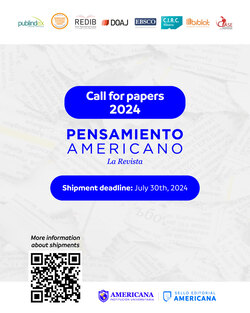The styles of teaching learning of the Catholic University of basin Azogues
DOI:
https://doi.org/10.21803/pensam.v12i24.334Keywords:
Evaluation, Learning, Evaluation techniques, Evaluation instruments, Evaluation functions and Evaluation typesAbstract
The purpose of this research is to sensitize all those involved in the educational event. Consider educational evaluation as part of the training process within teaching learning; this should not be considered as a curricular element of punishment, repression or something similar; According to the new precepts, the evaluation is a fundamental element to strengthen, reinforce and improve the interlearning of the learners, for which we must put this curricular aspect into practice at all times and make it a habit or a habit until turn it into a culture of teachers, parents and students; practicing the authentic evaluation, according to the concept of many students of the subject is to evaluate according to the context, capacity, interest, need and pace of learning, in addition the new regulations of the Country and a current at world level so requires it within the inclusive education. To put this type of evaluation into practice, the teacher must change his mental scheme, not consider it as an instrument that serves to accredit, pass of the year or cycle; but it must think like a resource or didactic means that is going away to use so that the apprentice learn to learn. Evaluation, Learning, Evaluation techniques, Evaluation instruments, Evaluation functions and Evaluation types.
Downloads
References
Acuñar-Ramirez, R., Ocampo-Hernández, C. & Vargas-Cubero, A. (2016). Logros de la experiencia de la comisión de evaluación de los aprendizajes. Revista electrónica calidad de la educación superior, 7(1). 53-76. Obtenido de: https://revistas.uned.ac.cr/index.php/revistacalidad/article/view/1376
Bezanilla, M. & Arranz, S. (2016). Sistema de evaluación de competencias en Educación Superior utilizando Moodle. Opción, 32(80), 290-310. Disponible en: https://www.redalyc.org/articulo.oa?id=310/31047691013
Chickering, A. & Gamson, Z. (1987). Seven Principles For Good Practice in Undergraduate Education. Washington Center News. Recuperado de: http://www.lonestar.edu/multimedia/SevenPrinciples.pdf
Díaz, F. & Barroso, R. (2014). DISEÑO Y VALIDACIÓN DE UNA PROPUESTA DE EVALUACIÓN AUTÉNTICA DE COMPETENCIAS EN UN PROGRAMA DE FORMACIÓN DE DOCENTES DE EDUCACIÓN BÁSICA EN MÉXICO. Perspectiva Educacional, Formación de Profesores, 53(1),36-56. Disponible en: https://www.redalyc.org/articulo.oa?id=3333/333329700004
Fernández, N. (2007). Educación Superior y Calidad en América Latina y Argentina: los procesos de evalua- ción y acreditación. Buenos Aires, Argentina: Universidad Nacional. Obtenido de
https://unesdoc.unesco.org/ark:/48223/pf0000217719
García,A.,Aguilera,M.,Pérez,M.&Muñoz,G. (2011).Evaluación de los aprendizaje en el aula. Opiniones y prácticas de docentes de primaria en México. México: Instituto nacional México. Obtenido de:
https://www.researchgate.net/publication/285578306_Evaluacion_de_los_aprendizajes_en_el_aula_Opiniones_y_ practicas_de_docentes_de_primaria_en_Mexico
González, J., Galindo, N. E., Galindo, J. L. & Gold, M. (2004). Los paradigmas de la Calidad Educativa. De la autoevaluación a la acreditación. México: CIEES. Obtenido de: http://files.didactica-desarrolladora1.web- node.es/200000009-2a6092b571/Paradigmas%20 de%20la%20Calidad%20Educativa.pdf
González, M. & Pino, M. (2016). Los estilos de enseñanza: construyendo puentes para transitar las diferencias individuales del alumnado. Revista Complutense de Educación 27(3). 1175-1191.
Gutiérrez, M. (2018). ESTILOS DE APRENDIZAJE, ESTRATEGIAS PARA ENSEÑAR. TENDENCIAS PEDAGÓGI- CAS, 31. 83-93. Obtenido de: https://repositorio.uam.es/bitstream/handle/10486/680833/TP_31_7.pdf?sequence=1
Hernández, L. (2010). Evaluar para aprender: Hacia una dimensión comunicativa, formativa y motivadora de la evaluación. Innovaciones educativas, 28. Obtenido de: https://www.raco.cat/index.php/Ensenanza/article/view/199619/353393
Keppell, M. (2006). Assessment & Evaluation in Higher Education, . Peer Learning and Learning-Oriented Assessment in Technology-Enhanced Environments, 31 (4), 453-464.
López-Pastor, V. M. (coord.) (2009). Evaluación formativa y compartida en educación superior. Propuestas, técnicas, instrumentos y experiencias. Madrid, España: Narcea.
Ministerio de Educación. (2011). Marco Legal Educativo. Quito: Editogranm S. A. Obtenido de
Mora, A. (2017). La evaluación educativa: Concepto, períodos y modelos. Actualidades Investigativas en Educación, 4(2). 166. Obtenido de: https://www.researchgate.net/publication/26429756_La_evaluacion_educativa_concepto_periodos_y_modelos
Reglamento de Régimen Académico del Consejo de Educación Superior. (2019). Capítulo I: Ámbito, Objeto, Objetivos, Funciones Sustantivas y Enfoques de Derechos. Obtenido de https://www.fomentoacademico.gob.ec/wpcontent/uploads/2019/05/REGLAMENTODERE%CC%81GIMENACADE%CC%81MICO.pdf
Rodríguez, I. (2017). La calidad de la educación superior y la reestructuración del programa de tutoría. RIDE Revista Iberoamericana para la Investigación y el Desarrollo Educativo, 8(15). Disponible en: https://www.redalyc.org/articulo.oa?id=4981/498154006004
Rodríguez, J. (2002). La evaluación de los aprendizajes de los alumnos universitarios. Enseñanza y aprendizaje en la educación universitaria, 120.
Salas Perea, R. & Salas Mainegra, A. (2017). Evaluación para el aprendizaje en ciencias de la salud. EDUMECENTRO, 9(1), 208-227. Recuperado de: http://scielo.sld.cu/scielo.phpscript=sci_arttext&pid=S207728742017000100013&lng=es&tlng=es.
Schón, D. (1992). La formación de profesionales reflexivos. Barcelona, España: Paidós. Obtenido de:
Varios, A. (2016). La evaluación Educativa. RIED, N.63.
Zubiria, J. (2010). Las implicaciones del diseño curricular. Colombia. Obtenido de
Downloads
Published
Versions
- 2019-06-22 (2)
- 2019-06-22 (1)
Issue
Section
License
Copyright (c) 2019 Pensamiento Americano

This work is licensed under a Creative Commons Attribution-NonCommercial-NoDerivatives 4.0 International License.
The author or authors of an article accepted for publication in the Journal Pensamiento Americano will transfer all of the patrimonial rights to the American University Corporation free of charge, within which are included: the right to edit, publish, reproduce and distribute both print media as digital, in addition to include in article in international indexes and / or databases, likewise, the Editorial Seal is authorized to use the images, tables and / or any graphic material presented in the article for the design of covers or posters from the same magazine. By assuming the patrimonial rights of the article, it may not be partially or totally reproduced in any printed or digital media without its express permission.
AUTHORITY ASPECTS
For the Pensamiento Americano Journal, all the authors of an article have made substantial contributions to the research and the manuscript, and they share the responsibility when the article presents errors, fraud in some way or violations of copyright.
After submitting an article, the journal does not accept the addition, deletion or change in the order of the authors, in addition we reserve the right to release the article when it has been submitted to the journal and under no circumstances will American Thought accept the article. withdrawal of an article during any phase of the editorial process






